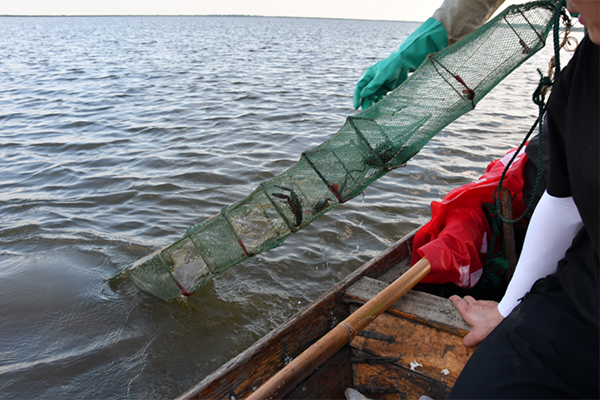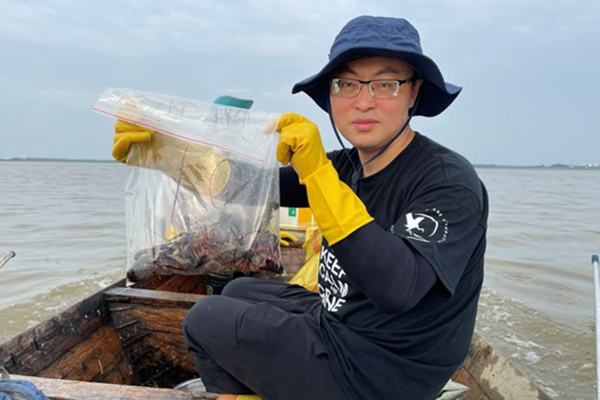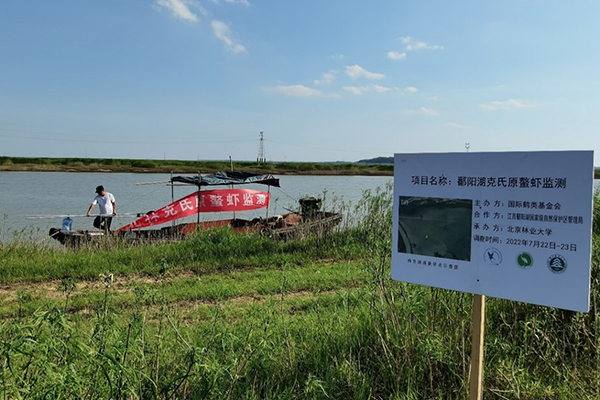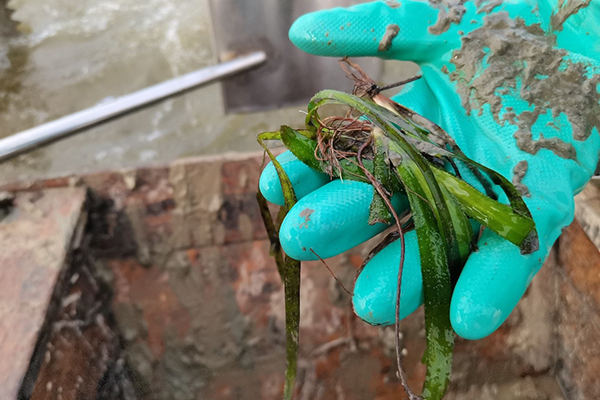June is the height of the summer in southeastern China, and the temperature at Poyang Lake was very high this year, reaching up to 39°C (102°F). In such weather, everyone hides in air-conditioning, but not our team, who went out to the four sub-lakes of Poyang Lake to conduct crayfish and submerged plant surveys!
The team got up early in the dark every morning to avoid the high temperatures during the day. Before the sun had fully risen, they set up crayfish traps at the pilot sampling points in the sub-lakes, collected water samples, and investigated the species and abundance of submerged plants. Even though the sunlight was less intense, the temperature did not lessen in the evening when the team collected the traps and cataloged the samples.
Submerged plants are the main food for cranes in winter, so, understandably, these should be investigated. But what is the relationship between crayfish and cranes? In the summer of 2020, very high water levels occurred in Poyang Lake, which were even higher than the catastrophic floods in the region in 1998. The high water levels caused a devastating blow to submerged plants, which need sunlight to grow. In addition, to cooperate with a fishing ban in the adjacent Yangtze River, a ten-year fishing ban was implemented at Poyang Lake this same year. Harvesting crayfish, an invasive species in the lake, was also banned.
Crayfish have a mixed diet, strong fertility, fast growth and wide adaptability. Therefore, in the absence of traditional human fishing, their population may expand rapidly and further affect the recovery of aquatic plants, which may cause food shortages for Siberian Cranes and other birds. In this context, it is necessary to determine the growth status of wild crayfish populations in the lake area and their relationship to the growth of aquatic plants through multiple-year or long-term systematic monitoring.

This species of crayfish, Procambarus clarkii, is native to the southcentral United States and northeastern Mexico. However, they are a highly destructive and widespread invasive species in freshwater ecosystems. Crayfish were introduced to Japan from the U.S. as bullfrog bait in the early 1920s and then introduced from Japan to Nanjing, China, in 1929. The new species quickly spread to most provinces in China and became a Chinese aquaculture species in the early 1980s. At present, wild populations of crayfish have been investigated in 13 provinces across the country, and their suitable habitats are mainly concentrated in the middle and lower Yangtze River.

With the support of the Department of Agriculture and Rural Affairs and Forestry Bureau of Jiangxi Province, our research this summer is the beginning of a three-year monitoring program at Poyang Lake with Beijing Forestry University, Jiangxi Poyang Lake National Nature Reserve and the International Crane Foundation. This research is undertaken by the team of Associate Professor Wang Yuyu from Beijing Forestry University.
Our research aims to assess the ecological risks that crayfish may bring to Poyang Lake, especially the key crane habitats, and to provide scientific suggestions for establishing a crayfish ecological monitoring system and ecological risk early warning, prevention and control system in Jiangxi Province.

From July 22 to 25, 2022, the joint investigation team carried out the first survey in the four sub-lakes of the Poyang Lake nature reserve. At the same time, the team also sampled aquatic plants and collected first-hand information. Preliminary survey results show that crayfish were surveyed in all four sub-lakes. However, some pilot sites have collected more than a dozen crayfish, and few have no crayfish, reflecting the species’ uneven distribution. And the shallow water pilot sites with rich aquatic plants have more crayfish.

The conditions of submerged plants in the four sub-lakes are not very optimistic, and submerged plants were found in only a few of the pilot sites. The results indicate that the submerged plants are still not fully recovered from the flood damage in the summer of 2020, even if the water levels this spring and summer were suitable.
Some of the crayfish collected will be used for control experiments to compare the effect of different densities of crayfish on submerged plants. So, in the hot summer, we hope that you can remember the story behind it and us when you eat delicious crayfish.



Story submitted by China Program Coordinator Hou Bo, Jin Jiefeng Poyang Basin Program Manager and Environmental Education Officer Liu Tao. Learn more about our work in East Asia.
